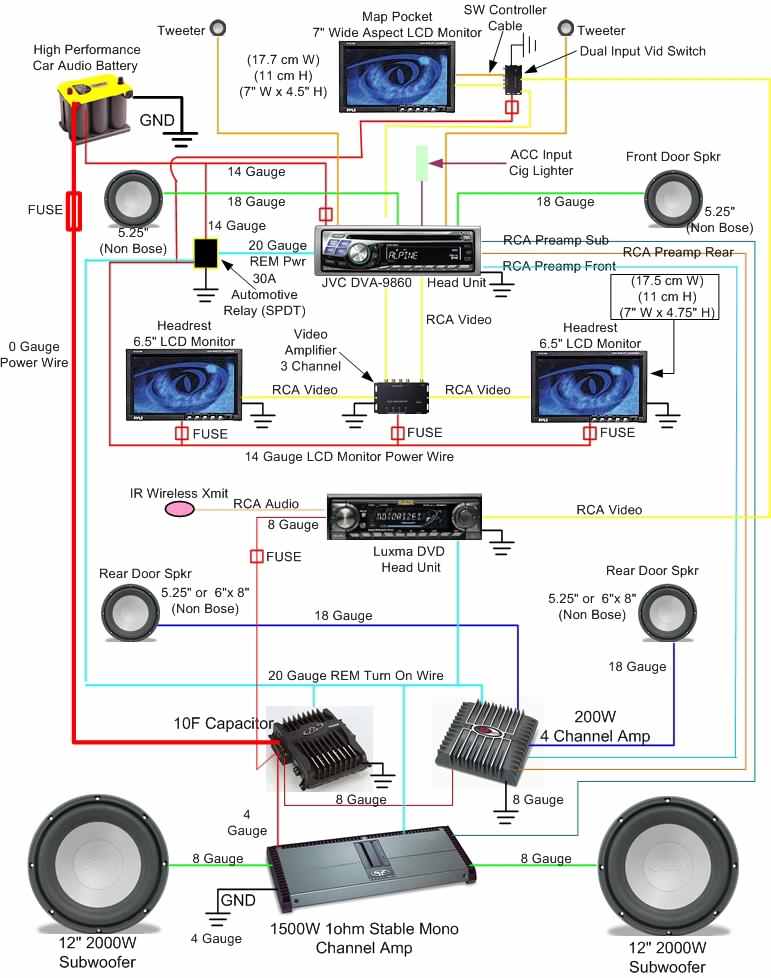Pump Up Your Ride: The Ultimate Guide to Car Radio Speaker Wiring
Ever dreamed of transforming your daily commute into a concert-quality listening experience? Or maybe you just want to replace those blown-out factory speakers with something a little more… thumping? Understanding car radio speaker wiring is the key to unlocking your car audio's true potential. It’s the hidden language that connects your head unit to those beautiful sound-producing cones, and we’re here to decode it for you.
Connecting your car speakers might seem daunting at first, but with the right guidance, it can be a surprisingly straightforward process. This comprehensive guide will equip you with the knowledge to confidently tackle your car audio setup, whether you're a complete novice or a seasoned audiophile looking to fine-tune your system.
From the early days of single-speaker AM radios to the complex multi-channel systems of today, car audio has come a long way. Initially, car radio speaker connection was a simple affair, but as technology advanced, so did the wiring complexity. The introduction of stereo sound, multi-speaker systems, amplifiers, and subwoofers added layers to the process, making a solid understanding of speaker wiring diagrams essential for achieving optimal sound.
One of the primary issues with incorrect car speaker wire configurations is impedance mismatch. This occurs when the impedance of the speakers doesn't match the output impedance of the head unit or amplifier. This can lead to reduced sound quality, overheating, and even damage to your equipment. Another common problem is improper grounding, which can introduce noise and interference into your audio system, resulting in that annoying buzzing or humming sound.
Understanding the basics of speaker wiring is crucial. "Impedance" refers to the resistance a speaker offers to the electrical current. It's measured in ohms (Ω) and is usually 4 or 8 ohms in car audio. "Polarity" indicates the positive and negative terminals of the speaker. Connecting the wires with incorrect polarity can result in out-of-phase sound, where the sound waves cancel each other out, leading to weak bass response.
Benefits of Properly Wiring Your Car Radio Speakers:
1. Optimal Sound Quality: Correct wiring ensures that your speakers receive the correct power and signal, resulting in clear, balanced, and distortion-free sound.
2. Protection of Equipment: Proper speaker wire installation prevents impedance mismatches and short circuits, protecting your head unit, amplifier, and speakers from damage.
3. Enhanced Bass Response: Correct polarity ensures that your speakers work in harmony, producing a full and powerful bass response.
Action Plan for Speaker Wiring:
1. Gather your tools: Wire strippers, crimping tool, electrical tape, and a wiring diagram specific to your car and head unit.
2. Disconnect the negative battery terminal for safety.
3. Identify the speaker wires from your head unit or amplifier.
4. Run the speaker wires to the appropriate speaker locations.
5. Connect the wires to the speakers, paying close attention to polarity.
Frequently Asked Questions:
1. Do I need an amplifier for aftermarket speakers? Not always, but an amplifier can significantly improve sound quality, especially with higher-powered speakers.
2. Can I mix different impedance speakers? It's generally recommended to use speakers with the same impedance.
3. What gauge speaker wire should I use? 16-gauge wire is suitable for most car audio systems, but thicker 14 or 12-gauge wire is recommended for higher-powered systems.
4. How do I identify the positive and negative terminals on a speaker? Usually, the positive terminal is marked with a "+" or a red dot.
5. What if my car stereo has more speaker outputs than I have speakers? You can leave the unused outputs unconnected.
6. How do I fix a buzzing sound in my speakers? Check for grounding issues or loose connections.
7. What are speaker adapters? They allow you to install aftermarket speakers in cars with factory speaker mounts.
8. Where can I find a wiring diagram for my car? Your car's owner's manual or online forums dedicated to car audio can be good resources.
Tips and Tricks:
Use high-quality speaker wire for better sound and durability.
Securely route your wiring to prevent rattles and interference.
Label your wires for easy identification.
Test your system before reassembling everything.
In conclusion, mastering the art of car speaker wiring empowers you to take control of your in-car audio experience. From diagnosing a simple wiring issue to installing a completely new sound system, the principles outlined in this guide provide the foundation for building a system that truly rocks. Remember, proper wiring ensures not only optimal sound quality but also protects your investment in your car audio equipment. So, take the time to learn the fundamentals, plan your installation carefully, and enjoy the rewards of a perfectly tuned sound system that will transform your daily drive. By understanding the importance of correct car radio speaker wiring connections, you’re not only enhancing your listening experience but also preserving the integrity of your audio equipment. So, turn up the volume and hit the road with confidence, knowing your car audio system is wired for sonic perfection!
Boletos de avion de honduras a guatemala
The curious case of the bic mechanical pencils length
Taming the metric system monster your converting metric units worksheet pdf guide














